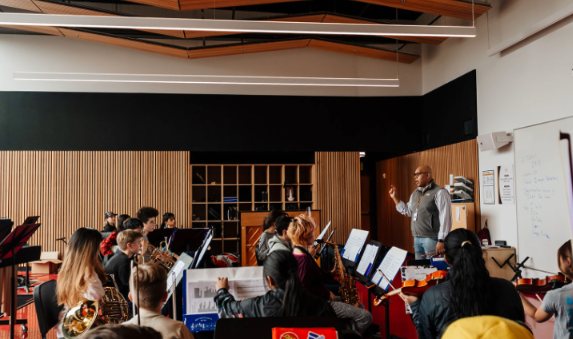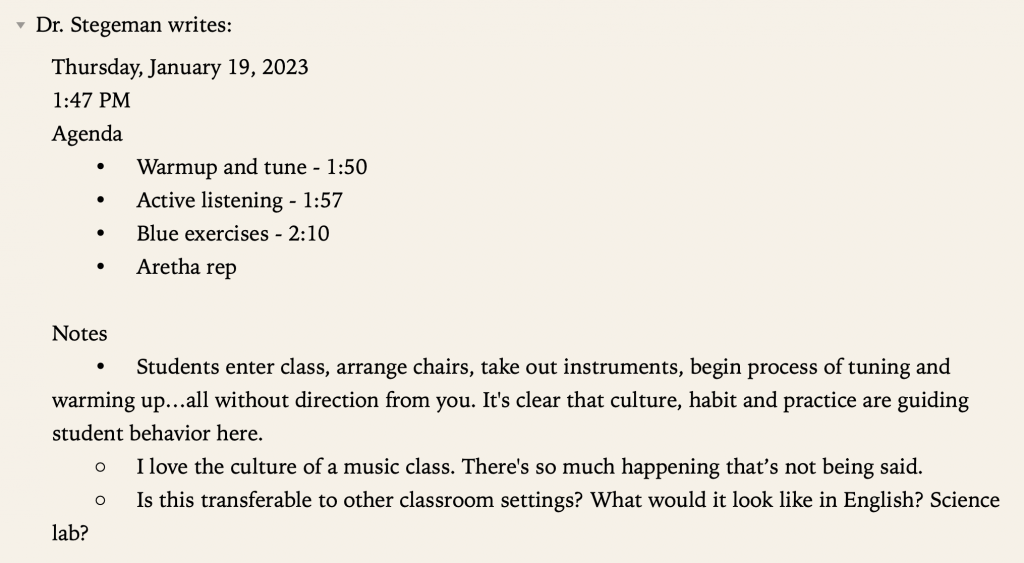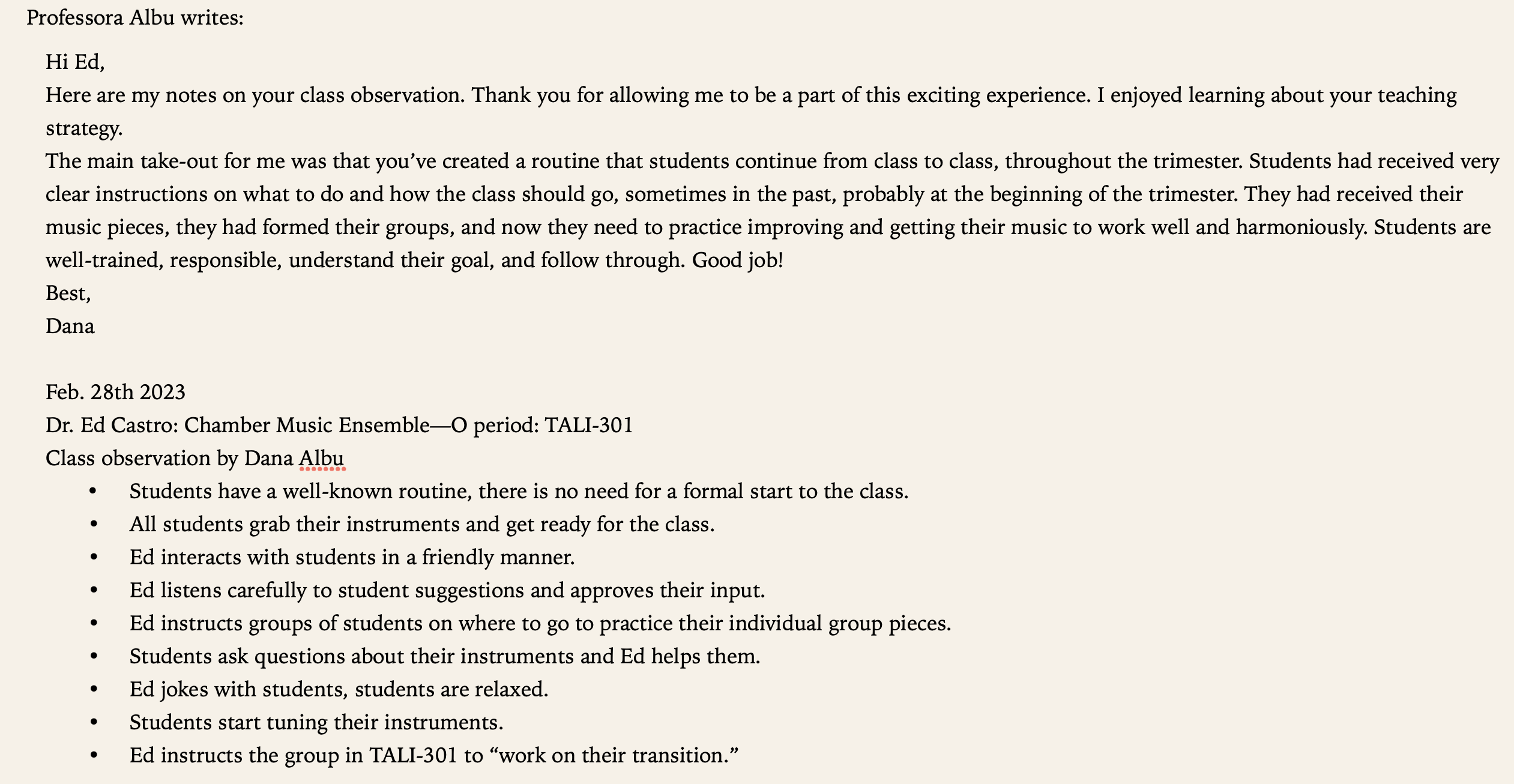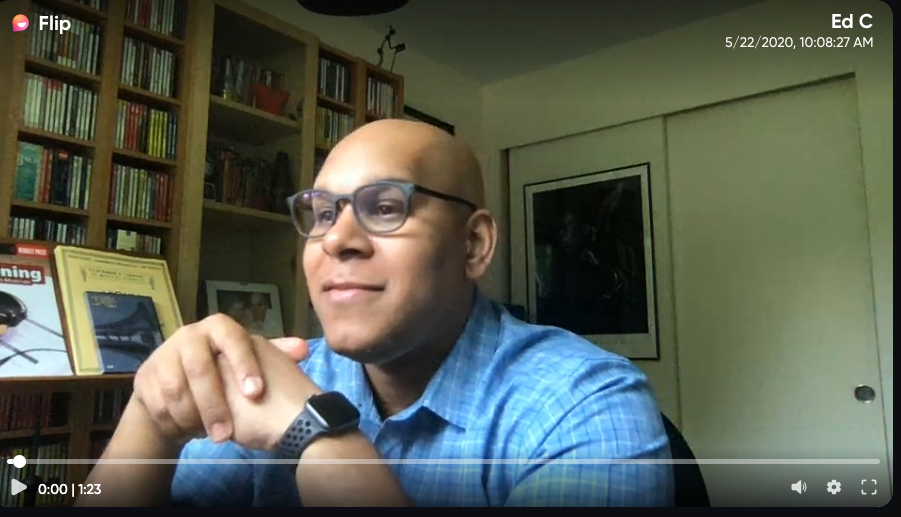When thinking about a classroom and its culture, there are several factors I use to create a safe environment for student engagement. The use of routine and habits of mind for the ensemble are crucial components to help create a cohesive ensemble. What is gained in an ensemble routine is student preparedness, engagement, self-advocacy, perseverance, and collaboration.

At different points, students will feel a sense of ownership in the process of creating artful experiences, and this ownership and confidence in the program typically reveal itself in performance.
The following indicators help categorize the evidence for my work:
- Coaches and reinforces peer-to-peer dynamics that are appropriate and constructive
- Communicates behavioral expectations that are appropriate to class activities
- Develops a mutually respectful relationship with each student, instilling confidence that the teacher is invested in their success
- Demonstrates cultural competence by promoting inclusivity
- Designs and facilitates a classroom culture that promotes student preparedness, engagement, self-advocacy, perseverance, and collaboration
(1) Coaches and reinforces peer-to-peer dynamics that are appropriate and constructive
Fostering positive peer-to-peer dynamics is an essential part of any chamber music experience. As a coach, I am responsible for setting clear expectations, encouraging collaboration, and recognizing positive moments of cooperation. Doing so helps create a positive and supportive learning environment where students feel empowered to take risks, share ideas, and grow personally and artistically. The video below demonstrates how peer-to-peer dynamics culminate in a performance. Of course, these strategies are effective within the context of a music class. Still, they can be applied to other classroom settings to create a more positive and productive learning experience for all students involved.
(2) Communicates behavioral expectations that are appropriate to class activities
The way in which I communicate behavioral expectations for the classes is established from the first day of class and is regularly implemented as part of our daily routine. Students are aware of the class setup and look to the board for information relating to the day’s topic. Students’ awareness of our daily routine extends to how we enter the orchestra studio and what materials are needed for the planned work for that particular class.

The class agenda or set of tasks is typically displayed on the board, and when it’s not listed, the agenda is communicated verbally.
These and more actions have helped set the behavioral expectations for my classes. Evidence supporting student actions are listed in the excerpts from several class observations from John Stegeman, Adam Waltzer, and Dana Albu. Click the observation notes below for more details.



Behavior and expectations are parts of a road that travels in both directions. Behavior, on my part, signals students that we will be transitioning between activities.
As in the examples above, the story I tell in this Flipgrid link is about my family’s behavior at the end of a particular class.
(3) Develops a mutually respectful relationship with each student, instilling confidence that the teacher is invested in their success
Developing a mutually respectful relationship with each student is essential to creating a positive classroom culture. As a music teacher, investing in my students’ success requires instilling confidence in their ability to understand their skills and limitations in creating art. I often take a hands-off approach to achieve this, allowing students to model rehearsal techniques I use in their small groups. While I may occasionally need to offer direct feedback to improve their technical abilities, my goal is to encourage them to take artistic chances with their learning, utilizing their individuality to explore and appreciate the music they want to learn. This approach fosters a culture of trust and mutual respect, where students feel comfortable taking creative risks and sharing their ideas. By creating a supportive environment where students can express themselves freely, I aim to cultivate a lifelong love of music in all of my students. Check out this video for a firsthand look at how classroom culture is affected as I develop a mutually respectful relationship with my music students.
(4) Demonstrates cultural competence by promoting inclusivity
For me, decolonizing my classical music curriculum was a pivotal moment in developing my teaching practice. It gave me a specific direction in which to cultivate a classroom culture that fosters inclusivity. One of the most potent tools I use in my classes is the concept of mirrors and windows as part of my curriculum.
I use the idea of a mirror to help students reflect on their own culture and build a positive sense of identity. The window, on the other hand, is a metaphor that offers students a view into someone else’s experience. By incorporating mirrors and windows into my curriculum, I aim to create a space where students can learn from and celebrate the diverse experiences and cultures that make up our world.
In order to achieve this, my curriculum needs to be fluid so that I can share perspectives that are not often seen in classical music. One of the most direct ways I do this is through the composers I choose to program for performances. While I may include well-known classical composers that are familiar to my students, I also introduce lesser-known composers or genres that are not typically associated with western-classical music. For example, in the Fall of 2021, my concert program featured the music of Wolfgang Amadeus Mozart, living American composer Marcus Norris, and famed R&B singer and composer Marvin Gaye.
Excerpts from my lesson plan from Spring 2021:
- Question for discussion:
- How do we define classical music?
- If it is tied to a region, do we consider it a different genre, or do we need to invent a different classification for that?
- Is this just classical music of the place where it was created?
Diversity Component: Nirmala Rajasekar & Marcus Norris

- One of the highest-rated opuses of TRILLOQUY from season 1 featured the music and musings of South Indian artists Nirmala Rajasekar and Thanjavur K. Murugaboopathi. As the team prepares for season 3, Garrett gives an intro to this replay and offers and few shout-outs to some fellow decolonizes.
- Marcus Norris’ first foray into making music came in the form of producing rap beats on pirated software installed on a Windows 98 computer that he Macgyvered together from spare parts while lying on the floor of his childhood bedroom.
- South Side Symphony – Peach Lemonade
By incorporating diverse perspectives and experiences into my curriculum, I hope to create a classroom culture that promotes inclusivity and cultural competence.
One of the other ways of showing cultural competence by promoting inclusivity is through social media posts. I don’t use social media as a tool in my classes; however, in my role as EICL Co-Coordinator, I have found it to be a wonderful way of sharing with the wider community some of what I get to discuss with my classes. Below are examples of social media posts shared by EPS in which I had a hand in helping craft.
(5) Designs and facilitates a classroom culture that promotes student preparedness, engagement, self-advocacy, perseverance, and collaboration
Instrumental and vocal music performance classes can be powerful tools for promoting student preparedness, engagement, self-advocacy, perseverance, and collaboration. By establishing clear expectations, fostering self-advocacy, promoting engagement and perseverance, and emphasizing collaboration and teamwork, I have created a classroom culture that helps students develop the essential skills they need for success in school and beyond.
One of the best examples of this occurred during our remote teaching during the 2020-2021 school year. As part of our music theory curriculum, in collaboration with performance aspects of instrumental skill building, students tied both aspects of music education to assignments due each week.

For more details about how I designed student experiences during our remote school year, use this Flipgrid Link to hear directly from me in the space I taught all my classes.
The video below will help give context to the various ways in which music at EPS takes place and the manner in which the culture of our classes is serious and fun.